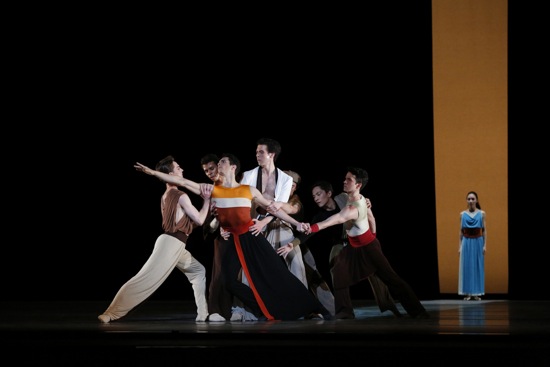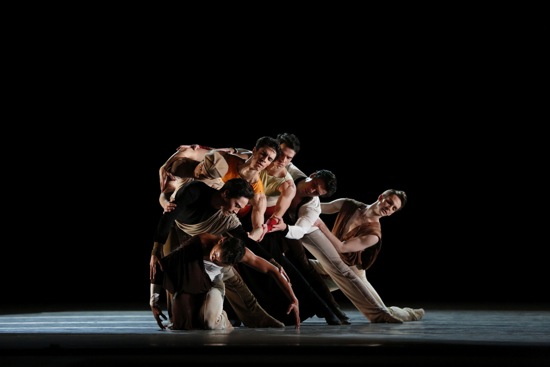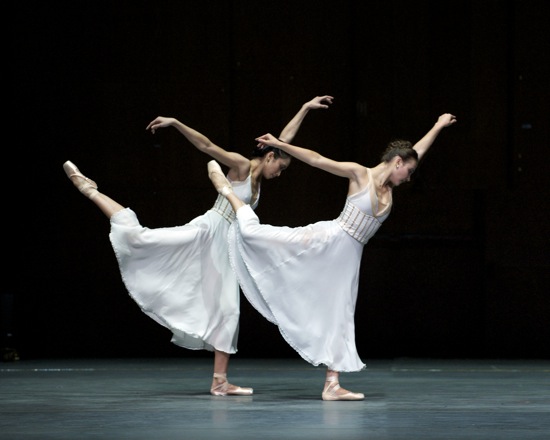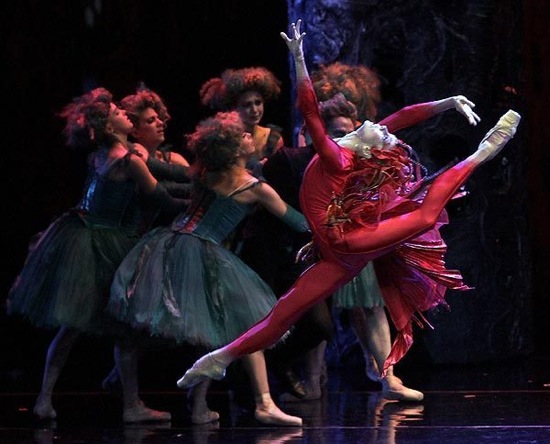Alexei Ratmansky introduces Plato to American Ballet Theatre in its Lincoln Center season.

American Ballet Theatre dancers in Alexei Ratmansky’s Serenade after Plato’s Symposium (Alexandre Hammoudi and Thomas Forster center, Hee Seo at back) Photo: Marty Sohl
Serenade after Plato’s Symposium is the twelfth ballet that Alexei Ratmansky has choreographed for American Ballet Theatre in the past seven years; clearly he takes his position as the company’s artist in residence seriously. This beautiful new chamber ballet is subtly different from anything of his that I’ve seen before, even though it shares characteristics with all of them.
The music that inspired him is Leonard Bernstein’s eponymous 1954 concerto for solo violin (finely played by Benjamin Bowman), strings, and percussion. The seven sections provide musical analogues to the speeches, delivered by the principal guests at the symposium that Plato wrote of late in the fourth century B.C.E. Seven men meet at the celebratory banquet, hosted by the poet and playwright Agathon, who has just won a prize for his first tragedy. Lounging on two-man couches, they eat, drink, and discourse on love—or Eros, as they dignify it. Aristophanes, the playwright of comedies, is there; so is the military man Alcibiades (who arrives late and drunk); so, importantly, is Socrates.
Bernstein drew on the celebrants’ speeches for the tenor of his variations, noting on the day after he had completed the score that “each movement evolves out of elements in the preceding one.” That idea reflects the nature of Plato’s symposium, in which each speaker agrees, disagrees, or takes off from what he has heard. Ratmansky has approached the music both sensitively and flexibly, not, I think, wanting us to see one dancer as representing Phaedrus and another Eryxymathus. Instead, he captures the quality of discourse written into the music and the nature of the long-ago event itself.
The seven men in Ratmansky’s ballet establish themselves as companions. They stand around or lounge on the floor as if on couches and watch whoever is “speaking” at present. They come and go, engage in movement dialogues, and assist anyone about to keel over or swoon from the thought of exalted love. They cement another’s points by dancing in unison or copying his moves. Because these are dancers with a common bond, Ratmansky defines them as intelligent conversationalists by creating solos that are as complex as thought and as virtuosic with these men’s bodies as Agathon’s guests are with their tongues. Their groupings suggest those of paintings depicting Plato’s scene or the sculptures of his era.
I didn’t see the cast that performed the piece at its premiere on the May 17 gala. The following night, all but Herman Cornejo were dancing it for the first time, and all performed superbly: Thomas Forster, Joseph Gorak, Alexandre Hammoudi, Tyler Maloney, Aaron Scott, and Jose Sebastian. They dance beneath a very large white screen by Jerome Kaplan that initially bears the word “Symposium” in Greek letters; it lifts, lowers, and tilts unobtrusively. Kaplan also designed the distinctive costumes. A few have the geometrical look of a modern painting; others have partial drapes that allude to Grecian attire; the one worn by Forster—white pants and a loose, open white jacket—wouldn’t be out of place in Athens today. Imagine a party whose host invited everyone to come in an outfit he’d never dare wear anywhere else.

The companions in Ratmansky’s Serenade after Plato’s Symposium. Photo: Marty Sohl
You can see yet again how brilliantly Ratmansky directs the dancers’ very specific focus. Their gaze shifts with the movement, enlivening the space around them and their own presence within it. Cornejo dances both the opening meditation and, later, the most rapid and intricate of the solos. His feet are as busy as a hummingbird’s wings, whether he’s springing into the air or marking the ground. Forster’s solo is remarkable for its variety—flamboyant but also drooping at moments; he flicks his fingers, balances while others skip around him. Scott exits from his solo with a speed-of-light chain of turns. For Maloney’s softer, airier dancing, Brad Fields dims his lighting. This is picking out details, but all the solos—for Gorak, for Sebastian as well— are rich and distinctively designed, although at times seeds of movement from one appear in another, in the same way thoughts do in Plato’s work. Forster and Sebastan bow to each other at the end of a “dialogue” (watched and interrupted by others) as if they’d come to an agreement.
The dancing is not really “about” love in the sense that the banqueters’ speeches are, but it can convey the effects of love on an individual—confusing him, delighting him, making him sad. No women attended Agathon’s party, but Socrates related his conversation with the (fictional) wise woman Diotima, who links Eros with ideas of beauty goodness, and immortality. “Diotima,” however, does arrive at Ratmansky’s gathering, suddenly, mystically appearing at the back of the space, when a narrow black panel rises to reveal Hee Seo against a vertical slit of blue sky, wearing a long tunic that’s almost as blue.
The duet between her and Hammoudi has some of the earmarks of a classical pas de deux in that she is lifted high; however the two do kneel and seem to converse with their hands. Perhaps because Diotima is, in a sense, Socrates’ alter ego, Ratmansky wished to convey both her partner’s veneration of her and the fact that they share equally in the ideas they’re “discussing.” In any case, the beautiful woman is soon gone, and the men return to their feast of shared virtuosity. In the end, side by side, they advance toward the audience, and pop into jumps, one by one down the line, before subsiding into a sculptural cluster. Curious, but this is Ratmansky’s terrific party, and if he wants to end it with a few fireworks, so be it.

Stella Abrera and Christine Shevchenko in Alexei Ratmansky’s Seven Sonatas. Photo: Marty Sohl
Serenade after Plato’s Symposium began a program that continued with Ratmansky’s Seven Sonatas (2009) and his Firebird (2012), both staged by Nancy Raffa. The sonatas are some of Domenico Scarlatti’s ravishing ones, excellently played by Barbara Bilach. Three couples come together as if at a gathering at which love, friendship, and good manners swim freely in the rippling music. ABT’s splendid dancers are grouped into couples: Stella Abrera and Calvin Royal III, Luciana Paris and Scott, Christine Shevchenko, and Forster. But the pairing doesn’t mean simply a string of pas de deux. Two men may dance with one woman. One person may dance alone. And again, Ratmansky finds ways to show us that these people are companionable. They share friendship the way they share the music, experiencing new discoveries, momentary elation, even sudden vertigo.

The original cast of Alexei Ratmansky’s Firebird, with Natalia Osipova leaping and enchanted maidens behind her. Photo: Gene Schiavone
Ratmansky’s Firebird, a version of the ballet by Mikhail Fokine and Igor Stravinsky that Diaghilev’s Ballets Russes premiered in 1910, remains as deliciously audacious as it was when I wrote about it four years ago (https://www.artsjournal.com/dancebeat/2012/06/flaming-magic-and-goofy-girls/). But it seems to me that the enchanted maidens are more at home in awkwardness now, and even more confusedly besotted with the imperious magician Kaschei (Roman Zhurbin), who regards them as his harem (although he’s especially interested in Cassandra Trenary, the only one who has a little gumption). Isabella Boylston, the leader of a whole flock of male and female firebirds, flashes through her role with an avian delight in the air and a flair for ferocity. And Ivan (Hammoudi) is rightfully heroic, perplexed, daunted, and helpless in this dizzy fairytale that Ratmansky has spun. I’d almost forgotten how much I love the final moments, when doors in those giant trees with branches that looked like lipsticks are opened and out step young men in white suits, looking as fresh as they’ve ever been, greeting each other as if at a high school reunion and happy to get their girlfriends back, not a jot the worse for wear.
